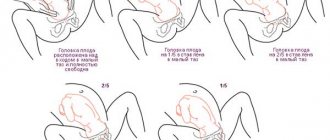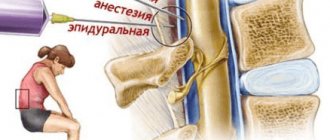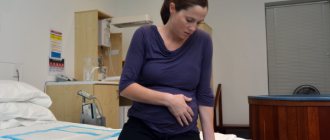What are the types of stitches after childbirth and how to care for them?
1. Sutures placed on the cervix.
Similar gaps occur during delivery of a large fetus.
They can be detected by a gynecologist during a postpartum examination in the mirrors. As a rule, there are typical places for ruptures - at three and nine “o’clock” (doctors draw this analogy with a dial for convenience). When stitching cervical ruptures, anesthesia is usually not performed. This is due to the fact that after childbirth she temporarily loses sensitivity.
Catgut, a biological tissue made from the wall of the small intestine of sheep, is used as a suture material. Catgut has the ability to dissolve, so there is no need for a second visit to the gynecologist to remove stitches. In addition to catgut, sutures after childbirth can be applied with semi-synthetic threads: vicryl, caproag, PHA. The seam can be continuous, or made in the form of separate stitches. Such internal seams after childbirth cause virtually no discomfort to the woman and do not require special care.
2. Stitches in the vagina.
During a traumatic birth, vaginal tears can be of varying degrees of depth. To eliminate the defect, both continuous and separate seams are performed. Catgut is used as a suture material. Unlike cervical ruptures, surgery to repair vaginal damage is much more painful. Anesthesia is local, using novocaine or lidocaine. After surgery, pain may persist for several days.
3. Stitches on the crotch.
Perineal ruptures can be natural - if it is damaged during childbirth, or artificial - the dissection is performed by a gynecologist. According to the degree of tissue damage, perineal ruptures are usually divided:
I degree - only the skin is damaged;
II degree - rupture of the skin and muscle fibers of the pelvic floor occurs;
III degree, the most severe - the rupture reaches the wall of the rectum.
During childbirth, the gynecologist may make a dissection of the perineum in order to help the baby see the light and avoid traumatizing the mother. If the dissection occurs in the midline, it is called a perineotomy. If at an angle of 45° - episiotomy. When incised, the perineal area is anesthetized with lidocaine.
In cases of II and III degrees of rupture, sutures are applied in several rows, first the deep-lying tissues are sutured, and then only the skin. The last row of sutures is applied with non-absorbable threads - silk or nylon. The suture hurts after childbirth with perineal ruptures for quite a long time. In order for the defect to heal well, rest and regular treatment with antiseptic solutions are required.
After each act of defecation and urination, the suture area should be treated with a pink solution of potassium permanganate. A similar procedure must be carried out not only in the maternity hospital, but also after discharge for two months.
To prevent the suture from coming apart after childbirth, you need to follow a gentle regimen.
For the first ten days, sitting down is strictly prohibited - you have to recline and eat, and do all the work while standing. Be sure to watch your stool - constipation should be strictly avoided. Eliminate bread and flour products from your diet. You should also not eat cereals for at least the first weeks. If there is no stool for several days, do a cleansing enema.
Causes and symptoms
It is necessary to detect the onset of complications in a timely manner, since the development of inflammation occurs rapidly. If you ignore or are unaware of the symptoms of tissue divergence, there is a risk of serious operations, including repeated suturing.
Why do stitches come apart after childbirth?
- infection;
- non-compliance with the motor regime;
- lifting a heavy load;
- active physical exercise;
- sexual intercourse;
- ignoring intimate care;
- failure to comply with processing recommendations;
- severe tension in the pelvic floor muscles (constipation);
- Shaping corrective underwear.
If the period of complete healing has not occurred, the stitches on the cervix come apart even during yoga or Pilates. If the external tissue is poorly sutured, uneven edges of the wound are observed, and symptoms of scar failure appear. But the appearance does not change if the discrepancy occurs due to physical activity.
How to understand that the stitches have come apart after childbirth:
- itching and burning appears;
- stabbing pain;
- edema syndrome;
- sensation of expansion of the pelvic bones;
- red or dark brown discharge;
- pus;
- dark edges;
- red inflammation around;
- weakness, pallor of the integument;
- temperature, possible fever.
In case of inflammation or suppuration of postpartum sutures, symptoms of the disease appear on the 3rd day from the beginning of the development of the process. In 50% of cases, the discrepancy is discovered in the maternity hospital, before discharge.
Why do gynecologists artificially create an incision during childbirth?
Many women ask a similar question, finding surgery during childbirth undesirable. Internal stitches after childbirth cause a lot of inconvenience and require additional measures. Reasons why doctors resort to surgical assistance to women in labor:
. Rapid birth.
In this situation, the fetal head experiences enormous stress. An episiotomy is performed to reduce it.
. Prevention of perineal rupture.
With a large head, the perineum may spontaneously rupture.
And in this case, its damage may be so deep that its further reconstruction will be difficult. When stitching such a tear, the likelihood of a dangerous complication—the seam coming apart after childbirth—is quite high. An incised wound heals much better and faster, and it is much easier to treat.
. With surgical dissection, the suture hurts for less time after childbirth.
. An episiotomy is also performed if a similar procedure was performed during a previous birth.
Due to scar tissue, the perineum loses its elasticity, and the risk of rupture increases many times over.
Useful video about perineal correction
There are internal
and
external
sutures, which are applied as a result of the obstetrician’s intervention in the birth process.
The incisions are made without painkillers to facilitate the birth process and speed up the passage of the fetus through the cervix. The most common situation is postpartum suture dehiscence
. In this case, surgery is not performed. The first sign of suture dehiscence is redness of the perineum, swelling and pain.
Suture materials:
- absorbable threads (natural and synthetic);
- metal brackets;
- non-absorbable threads.
What to do if the stitches come apart after childbirth?
This situation is quite dangerous and requires the immediate intervention of a qualified specialist. If your stitches come apart after childbirth, do not delay visiting your nearest antenatal clinic.
You can also seek help from the maternity hospital where the stitches were placed.
Reasons that caused the seams to diverge:
Sudden movements;
Suppuration;
Violation of the regime in the first ten days after birth.
If a fresh suture comes apart (on the first day after application), the doctor will treat the wound and re-tighten its edges. If the wound has already healed, but the suture has come apart completely, then the doctor’s tactics will be different - the edges of such a wound are excised, and the suture is reapplied.
Going to the toilet with stitches in the crotch
Going to the toilet for the first time “big time” in the first days after childbirth is always exciting for young mothers. After all, the risk of suture divergence from an episiotomy increases with excessive tension in the pelvic floor muscles. Therefore, it is important to try to avoid constipation.
The following recommendations will help you avoid problems with stool after childbirth:
- Eliminate from your diet foods that strengthen you: pasta, bread, rice, potatoes.
- Increase the consumption of foods that stimulate intestinal function: fresh vegetables, dairy products, beets, prunes.
- Use mild laxatives as prescribed by your doctor: Duphalac, Normaze, Microlax, glycerin suppositories.
- In the first 2 days after birth, stool retention is possible. This is due to prenatal bowel cleansing using an enema.
Incisions and stitches after childbirth, video
If there is a suspicion that the seams have come apart, this should be determined as quickly as possible. It is very rare for the internal seams to come apart and it is impossible to notice it yourself. This condition is determined by the doctor during examination and such sutures are usually left undisturbed. Mainly susceptible to this process. This occurs due to the act of defecation during constipation, sudden movements, if a woman sits down incorrectly and abruptly.
If the sutures come apart the day after childbirth, repeated sutures are applied. But if time has passed and the stitches come apart when the edges of the wound have already healed, the doctor decides whether to re-stitch. If a couple of stitches have come apart, there is no threat to life and health, then the seams are usually not touched. When the suture has completely come apart, a repeat operation is prescribed, in which the edges of the wound are excised and the sutures are reapplied.
Possible negative consequences and complications
If you ignore the signs of suture dehiscence, the woman feels pain and discomfort and risks infecting the wound. In the future, such a seam will look unsightly, the skin may be deformed, and the situation can only be corrected through plastic surgery. In the postpartum period, you need to closely monitor your well-being and the appearance of the suture. We list the possible negative consequences of seam divergence:
- Pain syndrome. If the nerve tissue in the vagina and perineal area is overly sensitive, a woman may experience serious discomfort. If, upon examination in a chair, no suture dehiscence is detected, the woman may be prescribed physiotherapy, heating, and quartzing of the genitals after complete contraction of the uterus.
- Development of infection. Pathogenic bacteria penetrate into an open wound, which leads to suppuration and inflammation. In advanced cases, the infection penetrates the genital tract, which leads to the development of gynecological diseases. Treatment usually requires antibiotic therapy.
- Bleeding. They most often occur due to mechanical trauma to the seam, which leads to its divergence. It is necessary to use anti-inflammatory drugs or re-suturing, otherwise after healing a wide and dense scar will form.
- Vaginal dilatation. Due to partial suture divergence, ignored by the woman or doctors, the volume of the vagina can significantly increase. This sometimes negatively affects the feelings of a woman and her partner during sexual intercourse.
What to do if the seams come apart?
In the maternity hospital, doctors examine the woman every day and quickly take the necessary measures if the stitches begin to come apart. If a woman, after being discharged from the maternity hospital, thinks that the stitches have come apart, she should immediately go to the antenatal clinic for an examination and a plan for further treatment.
After childbirth, the sutures may cause pain for the first couple of days, then the pain should go away. External seams can bother you for quite a long time, especially if you do not follow the regime. It is natural that pain occurs when trying to sit down, however, if it hurts in a calm state, this may be a signal of an inflammatory process. The pain cannot be tolerated and you should definitely consult a doctor.
There are no direct indicators that the suture has ruptured, other than bleeding. Therefore, you should not engage in self-analysis and if you have any suspicions (changes in pain or other sensations), be sure to consult a doctor.
Unfortunately, for most women, childbirth is so simple, it does not pass without consequences, and after a while various health problems begin to arise. For example, sutures placed during childbirth in the perineal area or on the abdomen after a cesarean section may well come apart.
After caesarean section
Scars after surgery are long and damage both internal and external tissues. The load from movement after such an operation is much higher, so control over healing is doubled.
The internal and external seams are made with organic threads. External wounds take 1-2 months to heal. If there is a risk of tissue divergence, the scar will diverge no earlier than 3 weeks after surgery. Internal wounds take much longer to heal. The scar on the uterus is finally formed from 1 to 1.5 years.
Prevention of suture dehiscence after cesarean section:
- ultrasound diagnostics after 1-3 months, then according to indications;
- local painkillers, oral tablets;
- carry out an external inspection once a month;
- antiseptic care;
- do not lift the baby if he weighs more than 3 kilograms;
- wear a support bandage or an elastic wide bandage on the stomach;
- Elastic belts or bandages should only be worn and secured in a lying position.
Dehiscence of the uterine scar can be fatal for the fetus and mother. If the suture does not heal correctly, complications arise during the second birth.
Tissue discrepancy can be avoided if you follow the recommendations of your doctor and conduct regular examinations. The only risk when care does not help is poor-quality surgical instruments and personnel errors during the operation.
Why can a postpartum suture come apart?
In fact, there can be a lot of reasons, and the seams often come apart for a reason. The simplest thing is to blame the doctors, yes, their fault also occurs, unfortunately! Sometimes negligence or the use of low-quality materials leads to such phenomena, but in most cases women are still to blame!
- Dehiscence of the seam occurs due to strong physical exertion. Many, forgetting about their still painful condition, lift heavy buckets of water, work a lot, often bend over, all this provokes this. In some cases, even caring for your own newborn baby can be difficult and someone needs to be involved until the stitches finally heal! It is therefore recommended not to hold the baby in your arms when feeding, not to feed him while standing, not to wash diapers yourself, etc.
- It’s not for nothing that a man’s physical intimacy is prohibited for two whole months after childbirth! A woman who follows the gynecologist’s recommendations will completely avoid further health problems, because the body needs time to recover. Therefore, if you have stitches, try to refrain from intimacy, well, at least for a month after giving birth.
- Mechanical damage - a blow, a fall and anything unexpected that is associated with a sharp change in body position can cause the threads used to tighten the seams to rupture, and they, having burst, simply ceased to perform their functions.
Usually, whatever one may say, every woman, faced with something like this, understands why her stitches could come apart. You always need to take care of yourself and avoid new problems!
Let's look at some features
In order for the stitches to heal quickly and not become inflamed, they need to be properly cared for. In the normal course, internal sutures are not processed at all , since sterile self-absorbable threads are used. There is enough hygiene care here.
But if the internal seams are inflamed or festered , then use tampons with levomikol or any other anti-inflammatory ointments.
External seams require special care . They should be treated 2 times a day . In the maternity hospital this is done by a nurse.
First, the seams are treated with hydrogen peroxide , and then with brilliant green or iodine. In addition to this, physiotherapy procedures are carried out to promote speedy healing.
A woman in labor should change her sanitary pad every 2 hours ; sterile disposable panties are used in the maternity hospital. You should wash yourself at least 2 times a day and after each bowel movement (and do this long after discharge). After washing (with potassium permanganate), the seams should be carefully blotted with a towel , but under no circumstances rub with it, then treated with peroxide, and then with brilliant green or iodine.
A woman always has a lot of troubles after giving birth. And problems with seams are only a small part of them. But believe me , a healthy baby snoring sweetly in your arms will atone for all your hard work and make you forget about all the difficulties associated with childbirth.
Many women who encounter stitches for the first time after childbirth do not know how to behave correctly so that the stitches do not come apart .
The most important thing is that a woman in labor with stitches should not sit down for 7-10 days under any circumstances. That is, eating, feeding the baby, swaddling and doing other work can only be done while lying down or standing.
At first it will be difficult to get used to this, and the desire to sit down will appear all the time. It is important not to do such a stupid thing, otherwise the seams will come apart.
Previously, it was much simpler, because the baby was brought only for feeding and immediately taken away, so the woman in labor could rest and get used to her new position. Women in labor with stitches were generally forbidden to stand up unless necessary, which is why the healing of the stitches after childbirth occurred much faster.
But now, when the baby is brought in on the first day and left with the mother until discharge, it is quite difficult to maintain bed rest, because you need to get up and swaddle the baby, wash him, and feed him. Well, how can you not forget and sit down out of habit?
Remember : you can sit down no earlier than after 10 days (and this is provided that the stitches heal well without causing complications), and then only on a hard chair, and after another 10 days - on a soft chair, bed or sofa.
Since the woman in labor is discharged on days 5-7 , the trip home will not be entirely comfortable; you will have to ride in the car in a semi-lying position . Warn your relatives in advance that only one passenger can travel with you in the car, since you will need more space.
There is one more point: in the first week after suturing, you need to go to the toilet “in large quantities” correctly . It is best to give an enema at the first urge, otherwise the sutures may also come apart due to tension in the pelvic muscles.
Read our article: “Valerian during pregnancy: dosage, instructions and more.”
And here we talk about problems in the early stages of pregnancy.
There is still a lot of interesting and useful information on our website.
What to do, the seams have come apart...
Some women try to hold out for a while, but what they hope for is unclear. Perhaps they are ashamed, understanding the reasons for the sutures coming apart, maybe this is ordinary negligence towards their health, but they do not go to the hospital for a long time. It is worth saying that it is completely in vain! Whatever caused the seams to come apart, they need to be re-stitched as soon as possible. As soon as you notice something like this, you need to rush to the hospital for help! Otherwise, there is a risk of infection, the wound still exists, and only God knows what kind of infection can get.
In addition, having lost time, the edges of the sutures will begin to heal and grow together again, which will be problematic for them, so before suturing the doctor will have to cut them off a little again in order to get to the “living” cells that can grow together with each other. It turns out that by not consulting a doctor in time, a woman creates a lot of new problems for herself and, I must say, pain.
No matter how much you would like not to go to the doctor again, even if the reason is too “personal” for you, in any case, overcome yourself and just “run” to the appointment. The sooner you ask for help, the sooner they will help you!
How to avoid seams coming apart
You can avoid suture dehiscence if you follow all the recommendations received from medical personnel regarding the care of the tear/incision sites and the behavior of the woman herself.
- A young mother should avoid physical activity, not lift heavy objects, even a newborn should be held and placed in the crib with caution and without sudden movements.
- You should not return to sexual activity too early. As a rule, two months are enough for healing, but if the doctor recommends avoiding sexual intercourse for a longer time, you should listen to him.
- It is important to eat in a way that prevents constipation. To do this, you need to drink more liquid, reduce or completely eliminate strengthening foods from your diet (white bread, rice, potatoes), give preference to vegetables and dishes containing a lot of dietary fiber.
- It is not recommended to sit down earlier than recommended by the doctor. If a specialist says that you can’t sit down for two weeks, then there is a need for it. The inconveniences associated with the ban are less burdensome than the problems that arise when the seam diverges.
- Personal hygiene must be strictly observed. Pads should be changed every two hours, and washed after each visit to the toilet, because lochia is a breeding ground for the proliferation of pathogenic microorganisms.
- You need to give up shapewear. It creates excessive pressure on the pelvic organs and perineum, which can cause the seams to diverge.
Taking care of yourself will help prevent troubles associated with sutures coming apart after childbirth. But even if this could not be avoided, do not despair. The help of specialists and the use of healing ointments will promote tissue scarring. And although the recovery period will last longer than usual, in the end all tears and cuts will definitely heal, because the female body is endowed with enormous power of self-healing.
During childbirth, it may be necessary to cut the perineum or, in the worst case, rupture of the vagina or cervix. Then obstetricians-gynecologists sew up the damaged tissue. Stitches can cause pain and inconvenience to a young mother, and with improper care and neglect of physical limitations, they can completely come apart, which will entail undesirable consequences.
Suture healing time
Women often wonder: how long does it take for a stitch to heal? The speed of healing is influenced by many factors: the skill of the surgeon, the material used, medical indications, incision technique and other factors.
Sutures can be applied using:
- Self-absorbable threads.
- Regular threads.
- Using special staples.
The material used has a big impact on how long the sutures take to heal after childbirth. When using the first type of material, wound healing takes one to two weeks. When a suture is applied using staples or regular threads, the healing period will average 2 weeks to a month. Sutures are removed a couple of days before discharge.
What to process?
During the acute phase, it is necessary to carefully care for the resulting damage - treat it with antiseptic solutions, as well as powders. This removes the inflammatory process well. Please note that you cannot peel off a dried napkin. It must first be moistened in a 3% solution of hydrogen peroxide. Then it will move away from the skin. The bandage should be pulled from the periphery of the wound to its center. Next, the wound is treated with the same solution. Pour a little of it onto the wound and wait until the hydrogen peroxide “fizzes.” Then blot the wound with a clean bandage and repeat the procedure until the area is clean. After this procedure, the wound should be kept open for 15 minutes. Ideally, 3-5 minutes of irradiation of the wound with an ultraviolet lamp. It clears up the infection and also speeds up healing.
The doctor may also recommend treatment with a solution of brilliant green, Fukortsin, Iodinol, or Iodopyron.
After the procedure, you need to apply a bandage with dimexide, which is diluted with saline in a ratio of 1:3. As an addition, a 1% solution of dioxidine is poured onto the compress. If there is suppuration in the wound, the specialist installs drainage or removes all skin sutures from this area. In the future it will be tightened by secondary tension. When the inflammation subsides, the edges of the injury can be tightened with a bandage.
Levomekol, ointments with panthenol and sea buckthorn oil are considered excellent wound healing agents. Milk thistle oil fights inflammation well, improves complete healing and resolves existing scars.
At the scarring stage, after two months, Contractubex or Mederma is used.
For more severe concomitant diseases that interfere with wound healing, a permanent or temporary mesh is applied. This prevents the damage from expanding.







